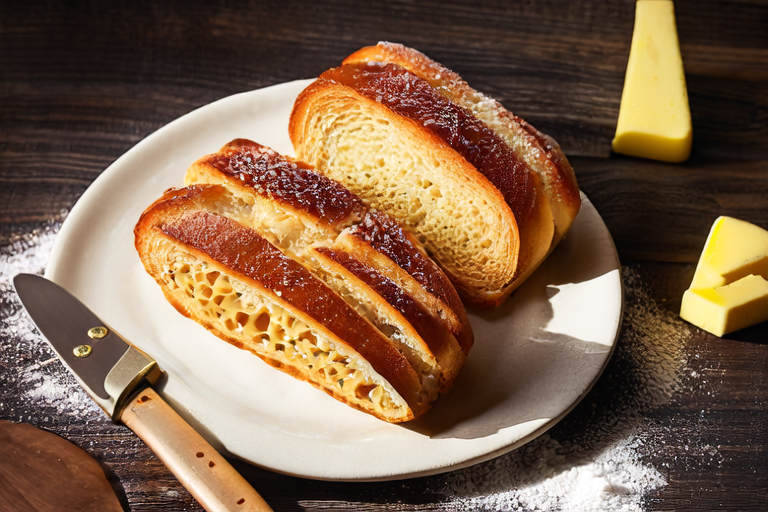The Art of Bread: A Gourmet Bakery Special
Welcome to this special edition of our gourmet bakery series. In today’s post, we delve into the world of bread – an essential and versatile element in the culinary arts. We will explore the science behind bread-making, discuss various types of bread, and provide you with a detailed recipe for creating your own gourmet bread at home.
The Science Behind Bread-Making
Bread is more than just flour, water, salt, and yeast. It is a complex interplay of chemistry and biology. The process of making bread involves several key steps:
- Mixing: This is where all the ingredients are combined. The type of flour used affects the texture and flavor of the final product.
- Kneading: Kneading develops gluten, which gives bread its structure. It also helps distribute the yeast evenly throughout the dough.
- First Rise (Proofing): During this stage, the yeast ferments and produces carbon dioxide, causing the dough to rise.
- Shaping: After proofing, the dough is shaped into loaves or rolls. Proper shaping is crucial for achieving the desired shape and appearance.
- Second Rise (Final Proof): The shaped dough is allowed to rise again before baking. This step ensures that the bread will have a light and airy texture.
- Baking: The final step in the bread-making process. Baking transforms the dough into a golden-brown loaf with a crispy crust and soft interior.
Varieties of Bread
Bread comes in countless varieties, each with its unique characteristics. Some popular types include:
- French Baguette: Known for its long, slender shape and crisp crust, the baguette is a classic French bread. It has a chewy interior and is perfect for sandwiches or simply enjoyed on its own.
- Italian Ciabatta: This flat, rectangular bread has a porous crumb and a crunchy crust. It pairs well with olive oil and is often used in Italian cuisine.
- German Rye: Made from rye flour, this bread has a dense texture and a slightly tangy flavor. It is often served with cold cuts and cheese.
- Irish Soda Bread: This quick bread uses baking soda instead of yeast and is traditionally made without any leavening agents. It has a moist, dense texture and is often served with butter or jam.
- Sourdough: Sourdough bread is made using a natural starter culture rather than commercial yeast. It has a tangy flavor and a chewy texture, and it is highly versatile.
Recipe: Classic Sourdough Bread
Today, we’ll focus on making a classic sourdough loaf. Sourdough is one of the oldest forms of leavened bread and is beloved for its complexity and depth of flavor.
Ingredients
- 1 cup active sourdough starter
- 2 1/4 cups all-purpose flour (plus extra for dusting)
- 1 tsp salt
- About 1 cup lukewarm water (adjust as needed)
Instructions
- Mixing: In a large bowl, combine the sourdough starter, flour, and salt. Gradually add the lukewarm water, stirring until the dough comes together. You may need to use your hands to fully incorporate the ingredients.
- Kneading: Transfer the dough to a floured surface and knead for about 10 minutes. The dough should become smooth and elastic. If it feels too sticky, add a little more flour; if it’s too dry, add a small amount of water.
- First Rise: Place the dough in a lightly oiled bowl, cover with a damp cloth, and let it rise in a warm place for 4-6 hours or overnight in the refrigerator.
- Shaping: Once the dough has doubled in size, gently punch it down and shape it into a round or oblong loaf. Place the shaped dough onto a parchment-lined baking sheet or a Dutch oven.
- Second Rise: Let the dough rise again for 1-2 hours or until it has doubled in size once more.
- Baking: Preheat your oven to 475°F (245°C). If using a Dutch oven, place it in the oven to heat up. Once hot, carefully place the dough inside, cover, and bake for 30 minutes. Remove the lid and continue baking for another 15-20 minutes, or until the crust is golden brown and the internal temperature reaches 200°F (93°C).
- Cooling: Allow the bread to cool completely on a wire rack before slicing. This allows the bread to develop its full flavor and texture.
Tips for Perfect Sourdough
Making sourdough can be a bit tricky, but with practice, you’ll master it. Here are some tips to help you achieve the best results:
- Use room temperature ingredients when mixing the dough.
- Ensure your starter is active and bubbly before using it.
- Be patient during the rising stages. Sourdough takes time to develop its flavor.
- Don’t over-knead the dough. It should feel slightly tacky but not sticky.
- Consider using a baking stone or Dutch oven to create a steamy environment, which helps produce a crisp crust.
Conclusion
Bread is an art form that combines simplicity with complexity. From the ancient methods of sourdough fermentation to the modern techniques used in artisan bakeries, bread-making is a craft that continues to evolve. By understanding the science behind bread and experimenting with different recipes, you can create delicious, homemade bread that rivals anything found in a gourmet bakery. Happy baking!


